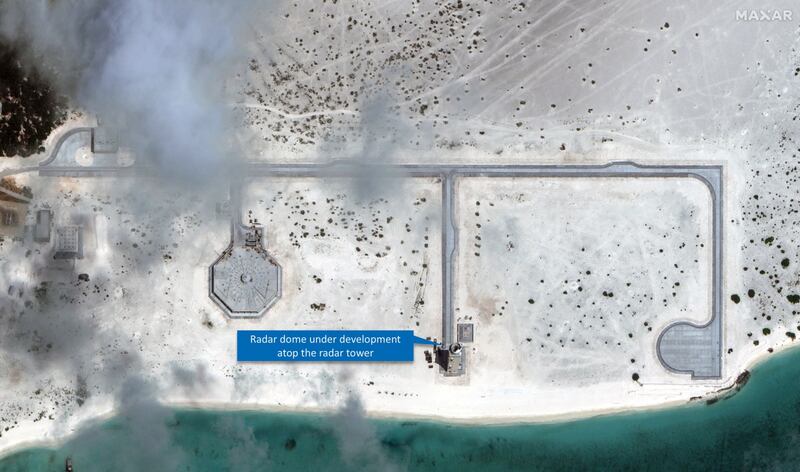China is developing one of the contested Paracel Islands into a major intelligence base in the northern part of the South China Sea, new satellite images analyzed by a British think tank revealed.
A new report by Chatham House found that Beijing has been building a massive new radar system on Triton – the westernmost and southernmost island in the Paracel archipelago, less than 250 kilometers (155 miles) from Vietnam's coast.
Vietnam and Taiwan also claim sovereignty over the Paracels but China controls the entire island chain after seizing it from the South Vietnam government in 1974. Beijing's deployment of a drilling platform near Triton island in May 2014 led to a serious standoff with Hanoi and triggered an unprecedented wave of anti-China protests in Vietnam.
Triton Island, called Zhongjian Dao in Chinese, also serves as a base point that China uses to draw a straight baseline to claim its territorial waters around the Paracel Islands. A U.N. arbitration tribunal in 2016 rejected this claim and the United States challenges it with its freedom-of-navigation operations in the area.

The enhanced radar facility on Triton, according to Chatham House’s report, would “offer a challenge to China’s competitors in the region and internationally.”
Satellite images provided by U.S. firm Maxar Technologies and analyzed by the report authors show the “striking development” of an advanced radar system known as SIAR, or synthetic impulse and aperture radar, “which purportedly detects stealth aircraft.”
The SIAR is characterized by its distinctive octagonal shape, similar to the one that the Chinese military built in 2017 on Subi Reef in the Spratly islands.
Several other structures on Triton have been identified as a radar tower, currently under construction, and facilities to store and launch anti-ship missiles or portable radars.
Implications for Vietnam
The radar system on Triton is the latest in a network of at least three counter-stealth radars, including those on Subi and Hainan islands, and “would significantly increase China’s signals intercept and electronic warfare capabilities across the disputed Paracel Islands archipelago and add to a wider surveillance network spanning much of the South China Sea,” said the report.
Michael Dahm, a senior resident fellow at the U.S. Mitchell Institute for Aerospace Studies, was quoted as saying that as SIAR radars cannot see over the curve of the Earth, the one on Triton – monitoring the area between those covered by the other two radars – will help close the surveillance gap between Subi Reef and Hainan Island and “give China contiguous counter-stealth radar coverage of the South China Sea.”
Vietnam would be the first at the receiving end with the report predicting that intelligence structures on Triton “would significantly diminish” the country’s capacity to operate undetected in the area.
“Alongside existing radar on Triton which can detect sea-going vessels, Beijing now has the potential to track Vietnamese air movements and gain forewarning of Hanoi’s maneuvers in the area, including efforts to access oil and gas deposits,” it said.

Chatham House analyst Bill Hayton suggested that new developments on Triton “might be a warning that China is planning to mount another drilling expedition.”
Radio Free Asia tried to contact Vietnamese authorities for comment but has not yet received a reply.
RELATED STORIES
[ EXPLAINED: What are the Paracel Islands and why are they disputed?Opens in new window ]
[ Vietnam says China attacked fishing boat near disputed islandsOpens in new window ]
[ China’s newly built Paracels airstrip could host drones, analyst saysOpens in new window ]
[ Report: Taiwan plans upgrade of runway on disputed islandOpens in new window ]
Last August, international media reported on the construction of a 600-meter (656 yard) runway on Triton that, albeit too short for patrol aircraft, could host drones.
The assumed “runway” turned out to be a road but Hanoi at the time voiced concern, saying that, “all activities in the Paracel Islands conducted without Vietnamese permission are violations of Vietnam’s sovereignty.”
Vietnam has also accused China of attacking one of its fishing boats near the Paracels last month, injuring 10 fishermen. China denied the accusation, and said the Vietnamese men were fishing illegally in Chinese waters.
Edited by Taejun Kang and Mike Firn.
